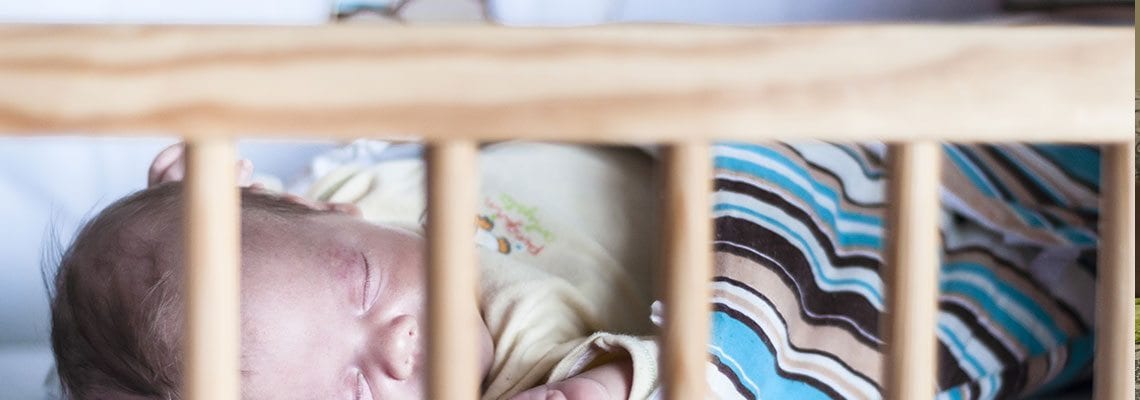
Guest author: Jenny Silverstone
Does the threat of Sudden Infant Death Syndrome (SIDS) have you losing sleep? Do you find yourself watching your baby’s every breath at night and losing out on your own sleep?
I get it. When I was a new mom, I hated to even leave the room when my child was sleeping. Although I knew the chance of SIDS happening was slight, it’s still a parent’s worst fear. One minute your child is sleeping peacefully and the next moment, they’re gone.
Before I started to imagine the worst however every time my child closed her eyes, I decided to make myself feel better by learning everything I could about SIDS and a baby’s sleeping habits.
Armed with my new-found knowledge, I felt more in control of the situation and less like a sitting duck.
I’m happy to use what I learned to help you work through your fears as well. This article will teach you everything you need to know about what happens when your baby rests its precious head.
Baby Sleep Safety; Why it Matters
 Getting enough sleep is important for all of us, but it’s especially vital for a baby. It’s during sleep that the blood supply for their muscles grows, the repair and growth of tissues takes place, and the body releases key hormones for development and growth.
Getting enough sleep is important for all of us, but it’s especially vital for a baby. It’s during sleep that the blood supply for their muscles grows, the repair and growth of tissues takes place, and the body releases key hormones for development and growth.
Sleep, or the lack of it, can impact a baby’s temperament, central nervous system and brain maturation, and even their cognitive abilities.
Because they are growing and developing so rapidly, babies need a lot of sleep. By the time they reach 2 years old, children will have slept 40 percent of their life.
A child’s sleep requirement is enormous, especially in the beginning. Here is how much sleep the average baby will need:
Until they are about two months old, babies need from 15 and one-half hours to 17 hours of sleep per day. By the time they reach three months old, they still need 15 hours of daily sleep.
From four months to 11 months old, they’ll require 12 to 15 hours per day. Toddlers, from the ages of 1 to 2 years old, should have anywhere from 11 to 14 hours of sleep. But, as much as sleep is needed, it’s not without risk.
Scary Statistics:
Every year, about 3,500 infants die from sleep-related causes in the U.S.
Accidental suffocation for babies has increased by 300% from 1984 to 2004.
Babies are 40 times more likely to die from suffocation while sleeping in a grown-up’s bed.
As scary as some of these statistics are, many of these deaths are preventable. It’s hard to say how many deaths could be prevented by simply educating parents, but some experts say the risk could be reduced by as much as 50 percent. In order to trim these numbers down and save lives, the word about sleep hazards for babies has to be spread.
SUID, SIDS and Fatal Sleep Accidents
Sleeping should be a peaceful time for both you and your baby. You’ve worked hard to make their nursery a calming, well-decorated place for them to rest, but, unfortunately, that nursery can be a scary place at times. There are many risks you have to be on the lookout for.
What Is SIDS?
Chances are, you know some things about SIDS already because it is a huge concern for parents everywhere. SIDS, is a risk for babies who are under the age of 1.
With SIDS, a baby who seems perfectly healthy can go to sleep just like any other night — the difference is they never wake up. They die in their sleep, leaving their devastated families to wonder what happened. This horrifying occurrence is most common in babies 6 months and younger, with 90 percent of SIDS cases happening in this age group. Those most at risk for SIDS are babies between the ages of 1 and 4 months. SIDS is only confirmed after every other possible known cause is ruled out.
SUID Vs SIDS Vs Fatal Sleep Incidents. What’s the Difference?
The nursery is one of the top spots where a sudden unexpected infant death (SUID) can occur. A SUID is when a death happens to a baby who is less than 1 year old and there is no cause of death that can be discovered immediately.
There are three main categories of SUID:
- SIDS.
- Accidental suffocation or strangulation in bed, which is broadly known as fatal sleep incident.
- Unknown causes.
In 2015, approximately 1,600 children died as a result of SIDS. Another 1,200 babies died from unknown causes, and approximately 900 more died because of accidental suffocation or strangulation while they were in bed.
In recent years, SIDS has continued on a downward trend from a high of 130.3 deaths per 100,000 live births in 1990. The rates have continued to drop in the years since then and were at 39.4 deaths per 100,000 in 2015.
But unlike SIDS, the number of deaths per 100,000 live births have begun to increase in recent years for both unknown causes and accidental suffocations. Because of the increases in both these categories, the overall SUID rate increased from 87.5 deaths per 100,000 births in 2014 to a higher number in 2015 of 92.6 deaths per 100,000 births.
Risk Factors for SUIDS/SIDS
There are certain conditions or factors that elevate the risk of SIDS and SUIDS. Some of the factors that are believed to increase the risk for SIDS and SUIDS include; premature birth, sleep safety, tobacco, delayed or inadequate prenatal care, alcohol and drugs, recent respiratory infection, young maternal age, having multiples, genetics, a room that’s too warm, and more.
But before you start having a panic attack because your baby falls into one of these categories, keep in mind the overall risk is still very low.
What Doesn’t Cause SIDS
 It can be tempting to try to link anything to SIDS, especially because of how random it appears to be. It’s hard not to wonder about what could cause a seemingly perfectly healthy baby to suddenly die.
It can be tempting to try to link anything to SIDS, especially because of how random it appears to be. It’s hard not to wonder about what could cause a seemingly perfectly healthy baby to suddenly die.
It’s natural to want to try to find a cause for it or pin it on some change in schedule or diet.
While you may not be able to figure out everything that can contribute to the risk of SIDS, you can safely rule a few factors out. There are some things that do not cause SIDS that parents might secretly wonder about. They include:
- Medication: Medication is not believed to cause SIDS.
- Contagions: SIDS is not contagious from child to child. Even if viruses play a small role in SIDS — which hasn’t been determined yet — most children who get viruses don’t die from SIDS.
- Vaccines: While many parents are leery about perceived harmful consequences of vaccines, SIDS is not caused by vaccinations. Since most infants do receive a series of vaccinations around the same time as SIDS occurs, it’s easy to understand why grieving parents might link the two. But studies have shown no spike in SIDS caused by vaccinations.
6 Common Myths About SIDS
Sometimes the hardest part of educating people is battling their misconceptions. There are a few myths about SIDS and SUIDS that moms should know about. These misconceptions may prevent parents from taking the necessary steps to protect their babies. That’s why it’s so important to dispel them.
1. Myth: Vaccines Cause SIDs
While many parents are leery about perceived harmful consequences of vaccines, SIDS is not caused by vaccinations. Since most infants do receive a series of vaccinations around the same time as SIDS occurs, it’s easy to understand why grieving parents might link the two. Studies have shown no spike in SIDS caused by vaccinations.
The only thing this myth does is open up babies to preventable diseases because their parents may be too scared to get them the vaccinations they need.
Believe in Science, Not Rumors:
While it’s understandable to be worried about things being injected into your baby, think about all the lives vaccines have saved over the years when you’re tempted to skip them.
2. Myth: Laying on Their Back Increases a Baby’s Risk of Choking
Babies spit up a lot, even when they sleep. Parents mistakenly believe if a child spits up while they’re lying on their back that they’ll choke on it. That used to be a commonly held theory generations ago, but doctors say there is no basis to it.
When babies do spit up in their sleep, they can turn their heads and keep their airways safe so this myth isn’t worth getting all worked up about.
3. Myth: Hooking Babies Up to Monitors Will Prevent SIDS
The only thing hooking up a baby to a monitor every time they go to sleep will accomplish is driving you crazy. Wearable monitors don’t seem to prevent SIDS, according to doctors. These monitors may go off so frequently that you’ll become annoyed by them. You might eventually turn them off anyway after you’ve had a lot of false alarms.
4. Myth: You Need to Reposition Your Baby to Their Backs If They Move
Your baby should always, without exception be placed on their backs to go to sleep. But what happens after your baby gets a bit older? If they roll over, do you have to keep repositioning them on their backs?
The answer to that is no. You’ll drive yourself crazy, and it’s not necessary anyway. By the time a baby reaches 6 months old, the risk of dying from SIDS decreases dramatically. Once your baby reaches the age where they can roll over, they are usually developed enough to realize when something is wrong. And they’ll be mature enough to roll back over if they find themselves in a pickle.
5. Myth: Putting a Baby on Their Back Is Enough to Stop SIDS
While babies should all sleep on their back because it has dramatically cut down on deaths from SIDS, it’s not a cure all.
The sad reality is that some babies are going to die from SIDS, even if they do sleep on their backs. But some of those deaths are because parents don’t always follow safe sleeping practices. Some of those practices include bed sharing with infants, letting them sleep with pillows and stuffed animals, and overestimating how warm a baby has to be while sleeping. It’s imperative to make sure your baby has their own surface to sleep on — one that doesn’t include you. If you want to be right by your baby, consider using a co-sleeper.
6. Myth: Parents Can Hear SIDS Happening and Prevent It
SIDS happens silently and quickly, it’s much like a drowning in that respect. Even the most attentive parent needs sleep too. And even if they were awake, there’s a good chance they wouldn’t even notice it happening.
As much as we parents would love to have nothing else to do than stare at our baby all hours of the day and night, we can’t. We need to sleep too. Our babies need to have healthy parents, and that includes us getting plenty of rest.
This myth might be one of the most harmful ones out there because it wrongly puts the blame on parents who may have done everything right. Parenting is hard enough without putting a guilt trip like this on other parents.
From the moment you find out you’re pregnant, your life will never be the same. You’ll be filled with worry about your baby’s safety, and one of those concerns will undoubtedly be SUIDS.
The traditional separation between a child’s room and a parent’s room has been evolving in recent years. As a parent, you need to look at your lifestyle, anxiety levels, and decide for yourself what will work best for you and your baby.
While room-sharing of some sort is an option, you can also have a perfectly safe baby if they have their own nursery.
Read over your options and do what feels right for your particular situation to ensure your baby has a healthy and safe sleeping arrangement.

Jenny Silverstone is the mother of two and has been deeply passionate about writing for just about as long as she can remember. Jenny is currently the main author at Mom Loves Best where she shares in depth guides and resources to help new parents better protect, care for, and enjoy their bundles of joy. When not tapping away furiously on her laptop keyboard, she enjoys camping and spending time outdoors with her family.


